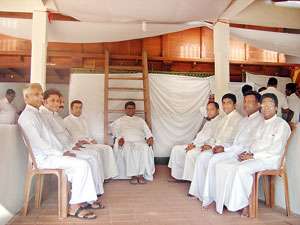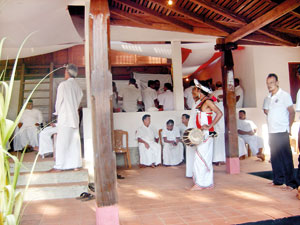Rituals connected with the Maligawa on Duruthu Poya day

The Diyawadane Nilame, Basnayake Nilames and other Maligawa officials in front of the atuwa
Every year, four main ‘Mangalya’(festivals) are celebrated in the Sri Dalada Maligawa in Kandy, beginning with the Aluthsahal Mangalya on Duruthu Poya.
According to the Mahavamsa, the Buddhist chronicle, the Buddha visited Lanka on three occasions. The first visit was on a Duruthu Full Moon Poya day to the Mahanaga Grove in Mahiyangana in the Uva Province, after the ninth month of the Buddha’s Supreme Enlightenment. The Buddha after spending His first Vas season (rains retreat) in Isipathana, proceeded to Uruvela and met the Jatilas brothers Uruvel Kassapa, Gaya Kassapa and Nadi Kassapa who were with one thousand of their followers. Buddha taught them to follow the correct path and made them achieve Sovan, the first state in the path to Nibbana. Thereafter he arrived at Mahiyangana. The Yakka tribe living there at that time were constantly fighting with the Naga Tribe. Wary of the Buddha’s presence, the Yakkas hid in the jungle. The Buddha requested them to come and listen to the Dhamma. Seeing the Buddha’s radiance and calm demeanour, they listened to Him and the Buddha was able to bring peace and harmony among them.
God Sumana Saman, who is the Chief Deity of the Samanala Adaviya, the mountain range listened to the Dhamma and reached the first state of Sovan. On a request made by him to give a relic to be worshipped after the Buddha leaves, a lock of hair (Kesha Dhatu) was given to him. This relic was placed in an urn and enshrined in a Dagaba which was built where the Buddha was present in Mahiyangana.
Duruthu Poya is very significant to the Sri Dalada Maligawa in Kandy. On January 4, the ceremonies for the Aluth Sahal Mangalya (distribution of paddy and rice) commenced. The ‘Atuwa’ (where paddy is stored) belonging to the Maligawa is in Pallakele, close to Kundasale. From the time of the Kandyan kings the paddy from the Haragama fields of the Maligawa were stored there. The Kariya Karawana Korala of the Maligawa said, “after these paddy fields went under water, the Maligawa was given fields in Yakkure in the Mahaweli Zone C in Dehiattakandiya.” The farmers who perform the ‘Rajakariya’ brought a half share of the paddy and rice to the ‘Atuwa’ in Pallakelle, around four in the afternoon on the 4th and handed over the paddy and rice to the Diyawadana Nilame and other Maligawa officials present. The day after, on the 5th, this paddy and rice was distributed to the Udarata (Upcountry) Vihara and Devala in the presence of the Diyawadana Nilame and the Basnayake Nilames of the Devala.
On Duruthu Poya Day, the Maligawa Muluthenge cooks and prepares 82 ‘seru’ of rice from the new harvest of paddy to be offered with the usual Sri Dalada Poojawa in the afternoon, with 32 vyanjana(curry) and other sweetmeats. This is to honour a vow made by the farmers before starting the paddy cultivation to bring them a good harvest. After the harvest, they always keep aside a portion to be offered first to the Sacred Tooth Relic in the Sri Dalada Maligawa.

Entrance to the Atuwa


